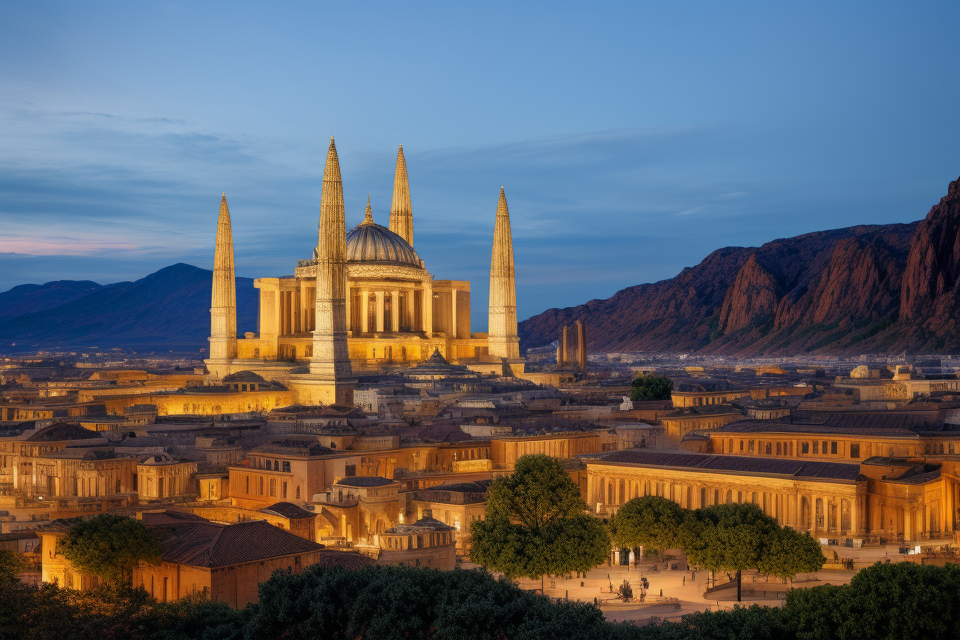Culture and heritage are two intertwined concepts that have been the subject of much debate and discussion. While culture refers to the customs, traditions, and beliefs of a particular group of people, heritage refers to the physical and intangible assets that are passed down from generation to generation. In recent times, there has been a growing awareness of the importance of preserving cultural heritage, with many countries and organizations working to protect and promote their cultural heritage. However, the question remains – can culture be a heritage? This comprehensive analysis aims to explore the connection between culture and heritage and examine the ways in which they intersect and influence each other.
Defining Culture and Heritage
Understanding the Meaning of Culture
Culture is a complex and multifaceted concept that has been studied by anthropologists, sociologists, and other scholars for many years. At its core, culture is a set of learned behaviors, beliefs, values, and traditions that are shared by a group of people. These shared characteristics help to define the identity of a particular group and distinguish it from other groups.
Culture plays a significant role in shaping individual and group behavior. It influences how people think, feel, and act, and it provides a framework for understanding the world around them. For example, a culture that places a high value on individualism may encourage people to be more independent and self-reliant, while a culture that emphasizes collectivism may encourage people to prioritize the needs of the group over their own.
One of the key features of culture is its diversity. There are countless different cultures in the world, each with its own unique set of characteristics. This diversity is important because it allows people to learn from one another and to appreciate the richness and complexity of human experience.
Furthermore, cultural diversity helps to promote social cohesion and stability by allowing people to recognize and respect the differences between themselves and others. When people are able to understand and appreciate different cultures, they are more likely to be tolerant and accepting of others who are different from themselves. This, in turn, can help to create a more harmonious and inclusive society.
Overall, understanding the meaning of culture is essential for anyone who wants to explore the connection between culture and heritage. By recognizing the importance of cultural diversity and the ways in which culture shapes individual and group behavior, we can gain a deeper appreciation for the complex and dynamic relationship between culture and heritage.
Understanding the Meaning of Heritage
Heritage refers to the cultural, historical, and natural assets that are passed down from one generation to another. It encompasses a wide range of tangible and intangible assets, including monuments, artifacts, traditions, customs, languages, and beliefs. Cultural heritage is a vital part of a community’s identity and serves as a source of pride and connection to the past.
One of the main reasons why heritage is important is that it helps to preserve the history and traditions of a community. It provides a sense of continuity and connection to the past, allowing individuals to understand their own history and the history of their community. Through the study of heritage, people can learn about the cultural, social, and political context of their ancestors, which can help to shape their own identity and values.
Another reason why heritage is important is that it can provide a sense of belonging and identity for individuals and communities. Cultural heritage is often passed down through families and communities, and it helps to create a sense of shared history and tradition. This shared identity can help to foster a sense of community and belonging, which is essential for the well-being of individuals and societies.
Preserving cultural heritage is also important because it helps to ensure that future generations can learn about and appreciate their cultural history. Without preservation efforts, many aspects of cultural heritage may be lost or forgotten, leaving future generations with a limited understanding of their cultural history. This can lead to a loss of identity and a disconnection from one’s cultural roots.
In conclusion, cultural heritage is a vital part of a community’s identity and history. It provides a sense of continuity and connection to the past, and it can help to foster a sense of belonging and identity for individuals and communities. Preserving cultural heritage is essential for ensuring that future generations can learn about and appreciate their cultural history.
The Relationship Between Culture and Heritage
The Interdependence of Culture and Heritage
Culture and heritage are interdependent concepts that are deeply intertwined. Culture refers to the beliefs, customs, values, and behaviors that characterize a particular group of people, while heritage refers to the physical and intangible assets that are inherited from past generations and passed down to future generations.
- How culture shapes heritage: Culture shapes heritage by influencing the way people perceive and value their past. It affects the types of artifacts, structures, and landscapes that are considered important and worth preserving. For example, a culture that places a high value on the importance of family will likely have heritage sites that reflect this value, such as family homes or graveyards.
- How heritage shapes culture: Heritage, on the other hand, shapes culture by providing a connection to the past and defining a sense of identity. It influences the way people think about themselves and their place in the world. For example, a heritage site that commemorates a significant event in a community’s history can foster a sense of pride and belonging among its members.
- The role of cultural heritage in preserving and transmitting cultural traditions: Cultural heritage plays a crucial role in preserving and transmitting cultural traditions. It helps to maintain a sense of continuity and connection to the past, as well as to promote a sense of shared identity among members of a community. For example, traditional festivals and celebrations that are rooted in a community’s cultural heritage can help to foster a sense of belonging and shared identity among its members. Additionally, cultural heritage can also provide a source of inspiration and creativity for contemporary artists and designers, helping to shape and influence the cultural landscape of a community.
The Impact of Globalization on Culture and Heritage
- Globalization has had a profound impact on culture and heritage around the world.
- The rapid spread of technology and communication has facilitated the exchange of ideas and cultural practices across borders, leading to a blending of different cultures and traditions.
- At the same time, globalization has also resulted in the homogenization of cultures, as dominant cultural forces often push smaller or weaker cultures to adopt their practices and beliefs.
- The spread of global media, popular culture, and consumerism has led to the rise of a global culture, which can erode the unique cultural identities of local communities.
- As a result, the preservation of cultural heritage has become increasingly important in the face of globalization, as it helps to maintain the distinctiveness and diversity of cultures.
- Cultural heritage also plays a crucial role in promoting cultural diversity and understanding, as it allows people to appreciate and learn from the traditions and practices of other cultures.
- In conclusion, the impact of globalization on culture and heritage is complex and multifaceted, and it is important to strike a balance between preserving cultural heritage and embracing the benefits of globalization.
The Significance of Cultural Heritage
The Value of Cultural Heritage
The Intrinsic Value of Cultural Heritage
Cultural heritage holds an intrinsic value that is deeply rooted in its historical, artistic, and scientific significance. This value lies in the unique stories, traditions, and practices that have been passed down through generations, preserving the essence of a community’s identity and heritage. By studying and appreciating the intrinsic value of cultural heritage, we can gain a deeper understanding of the human experience and the world we live in.
The Instrumental Value of Cultural Heritage
Cultural heritage also has an instrumental value, as it contributes to the development of society in various ways. This value is evident in the economic, social, and environmental benefits that cultural heritage provides. For instance, it can attract tourists, create jobs, and contribute to the preservation of local environments. By recognizing the instrumental value of cultural heritage, we can appreciate its role in fostering growth and sustainability in communities.
The Emotional Value of Cultural Heritage
Finally, cultural heritage holds an emotional value that is inextricably linked to our sense of belonging and identity. This value is reflected in the emotional connections people have with their cultural traditions, which can provide comfort, a sense of security, and a feeling of unity. By acknowledging the emotional value of cultural heritage, we can understand the profound impact it has on individuals and communities, and how it shapes our perceptions of the world.
The Importance of Preserving Cultural Heritage
- Cultural heritage serves as a repository of a community’s shared history, values, and traditions, and it is essential to preserve it for future generations.
- The preservation of cultural heritage allows for the transmission of knowledge and cultural practices to younger generations, enabling them to understand their cultural identity and history.
- This transmission of cultural knowledge is crucial for maintaining the continuity of cultural practices and traditions, ensuring that they are not lost or forgotten.
- Preserving cultural heritage promotes social cohesion and harmony within a community.
- Cultural heritage serves as a unifying factor that brings people together, fostering a sense of belonging and shared identity.
- By preserving cultural heritage, communities can celebrate their diversity and promote mutual understanding and respect among different groups.
- Cultural heritage also plays a vital role in promoting economic development.
- Cultural heritage can be a significant source of income for communities, through tourism, cultural events, and the sale of cultural products.
- Preserving cultural heritage can also attract investment and stimulate economic growth, as it can enhance the image of a community and make it more attractive to visitors and investors.
Challenges in Preserving Cultural Heritage
Threats to Cultural Heritage
Natural disasters and their impact on cultural heritage
Natural disasters, such as earthquakes, hurricanes, and floods, pose a significant threat to cultural heritage sites. These events can cause damage to structures, erosion of monuments, and loss of artifacts. In addition, the destruction of cultural heritage sites can also lead to the loss of cultural identity and history. For example, the 2004 Indian Ocean earthquake and tsunami severely damaged the ancient city of Sigiriya in Sri Lanka, causing extensive damage to the site’s fortress and monuments.
War and conflict and their impact on cultural heritage
War and conflict can also have a devastating impact on cultural heritage sites. During times of conflict, cultural heritage sites are often targeted for destruction, either intentionally or as a result of crossfire. This destruction can result in the loss of irreplaceable cultural artifacts and historical structures. For instance, the destruction of the ancient city of Palmyra by the Islamic State group in Syria resulted in the loss of many valuable artifacts and historical structures.
Urbanization and its impact on cultural heritage
Urbanization can also pose a threat to cultural heritage sites. As cities expand, cultural heritage sites may be destroyed to make way for new development. In addition, the construction of new buildings and infrastructure can also cause damage to cultural heritage sites. For example, the construction of a new highway in India led to the destruction of several ancient monuments and artifacts.
Overall, these threats highlight the need for effective preservation and protection measures to be put in place to safeguard cultural heritage sites for future generations.
Strategies for Preserving Cultural Heritage
- The Importance of Community Involvement in Preserving Cultural Heritage
- Empowering local communities to take ownership of their cultural heritage
- Encouraging the participation of young people in cultural heritage preservation
- Creating opportunities for community-led research and documentation of cultural heritage
- The Role of Government and Non-Government Organizations in Preserving Cultural Heritage
- Providing funding and resources for cultural heritage preservation projects
- Encouraging the development of cultural heritage policies and regulations
- Facilitating partnerships between government and non-government organizations to support cultural heritage preservation
- The Importance of International Cooperation in Preserving Cultural Heritage
- Sharing knowledge and best practices across national and cultural boundaries
- Supporting the exchange of cultural heritage professionals and students
- Facilitating the protection of endangered cultural heritage sites across borders
In order to effectively preserve cultural heritage, it is essential to employ a range of strategies that involve various stakeholders. This section will delve into the importance of community involvement, the role of government and non-government organizations, and the significance of international cooperation in the preservation of cultural heritage.
Community Involvement in Preserving Cultural Heritage
Community involvement is a critical component of cultural heritage preservation. By empowering local communities to take ownership of their cultural heritage, they are more likely to protect and preserve it for future generations. This can be achieved by encouraging the participation of young people in cultural heritage preservation initiatives, creating opportunities for community-led research and documentation of cultural heritage, and providing resources and support for community-based preservation projects.
Government and Non-Government Organizations in Preserving Cultural Heritage
Governments and non-government organizations play a crucial role in the preservation of cultural heritage. They can provide funding and resources for cultural heritage preservation projects, encourage the development of cultural heritage policies and regulations, and facilitate partnerships between government and non-government organizations to support cultural heritage preservation efforts.
International Cooperation in Preserving Cultural Heritage
International cooperation is essential for the preservation of cultural heritage, particularly for endangered cultural heritage sites that cross national borders. By sharing knowledge and best practices across national and cultural boundaries, supporting the exchange of cultural heritage professionals and students, and facilitating the protection of endangered cultural heritage sites, international cooperation can greatly enhance the effectiveness of cultural heritage preservation efforts.
FAQs
1. What is meant by culture and heritage?
Culture refers to the set of values, beliefs, customs, traditions, and behaviors that are shared by a group of people. Heritage, on the other hand, refers to the legacy or inheritance that is passed down from one generation to another.
2. Can culture be a heritage?
Yes, culture can be considered as a form of heritage. Culture is a collection of traditions, customs, and beliefs that are passed down from one generation to another. It is a vital part of a community’s identity and history, and it is often considered a valuable part of a community’s heritage.
3. What is the relationship between culture and heritage?
Culture and heritage are closely related concepts. Culture is a living expression of a community’s heritage, and it is often passed down through generations. Heritage, on the other hand, is the legacy or inheritance that is left behind by a community’s culture. Together, culture and heritage help to shape a community’s identity and history.
4. How is culture preserved as heritage?
Culture is preserved as heritage through various means, such as through festivals, celebrations, cultural events, museums, and cultural centers. Additionally, cultural artifacts, such as art, music, literature, and historical sites, are also preserved as part of a community’s heritage.
5. What is the importance of preserving culture as heritage?
Preserving culture as heritage is important because it helps to maintain the identity and history of a community. It also helps to promote understanding and appreciation of different cultures, and it can provide a sense of belonging and connection to one’s community and history. Additionally, preserving culture as heritage can also help to promote tourism and economic development.



